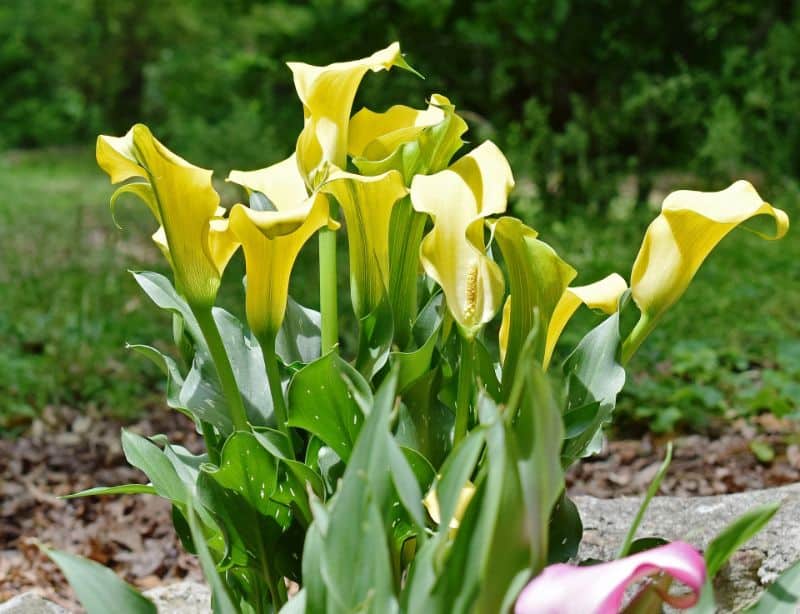Are you looking for a beautiful, easy-to-grow flower to add to your garden? Look no further than the calla lily! This lovely flower is perfect for any gardener, regardless of experience. In this article, we will share some tips on how to grow and care for Calla Lilies. Keep reading to learn more!
Best Calla Lily Varieties
| Image | Name | Rating | Shop |
|---|---|---|---|
 | Deluxe Exclusive Calla Combo | ||
 | Pasja Calla Lily |
How to Grow and Care for Calla Lillies
Calla Lily Hardiness Zones
The Calla Lily is a beautiful flower that is perfect for adding a touch of elegance to any garden. These flowers are native to South Africa and grow best in warm climates. In the United States, they are typically hardy in zones 8 to 10.
How Much Sun Do Calla Lillies Need
Full to partial sun is generally ideal for calla lilies. They’ll do best in an area that gets 6-8 hours of sunlight per day, though they can also tolerate some shade.
Calla Lily Soil Requirements
When it comes to soil requirements, calla lilies are not particularly fussy. They will grow in just about any type of fertile, well-drained soil. They even tolerate clay soils quite well. Just make sure that the soil is not too wet or soggy, as this can cause the bulbs to rot.
If you are unsure about the drainage in your garden, it’s always a good idea to install a raised bed or use a planting mix that contains perlite or vermiculite to help ensure good drainage.
Calla Lily Soil pH
As a general rule, calla lilies prefer a soil pH of 6 to 7. This slightly acidic range is ideal for most bulb plants, as it helps promote healthy growth and prevents common nutrient absorption problems.
If your soil is too alkaline (pH 8 or higher), you can mix in some sulfur to lower the pH. Conversely, if your soil is too acidic (pH 5 or lower), you can add some lime to raise the pH. You should always test your soil before planting calla lilies to make sure it falls within their preferred range.
Calla Lily Plant Spacing
When it comes to plant spacing for calla lilies, a minimum of 2 feet is recommended. This will ensure that the plants have enough room to grow and that they’re not too crowded. If you’re looking to create a more dense planting, you can reduce the spacing to 1 foot, but keep in mind that this may result in the plants requiring more frequent watering.
Calla Lily Temperature Requirements
Calla lilies are heat-loving flowers! They prefer temperatures of around 60-80F, so if you live in an area with milder winters, they will be a good choice for you. Just make sure to provide them with plenty of sunlight and water, and they should do just fine.
Calla Lily Fertilizer Requirements
Calla lilies do best when they’re fertilized with a well-balanced fertilizer every spring. However, it’s important to avoid over-fertilizing them, as this can actually be harmful. A light application of fertilizer is all that’s needed to keep your calla lilies looking their best.
Calla Lily Water Requirements
Calla lilies need about one inch of water per week, although you can give them a little more if the weather is hot or dry. Be careful not to overwater, though, as this can cause the bulbs to rot. You can tell if your lilies need water by inspecting the soil; if it feels wet then they don’t need anymore, but if it feels dry then give them a light watering.
Calla Lily Humidity Requirements
Calla Lillies appreciate high humidity in a range between 60-90% relative humidity. If you live in a particularly dry climate, regular misting of the leaves will be necessary to prevent the flowers from wilting.
Calla Lily Pests
There are a few different pests that can affect calla lilies including aphids, slugs, and spider mites. If you see any of these pests on your calla lilies, take action immediately to remove them before they do too much damage
Related Articles:
Calla Lily Diseases
There are a few diseases that can affect calla lilies, but the most common ones are bacterial soft rot and botrytis.
Both bacterial soft rot and botrytis can be treated with fungicides, but it’s important to diagnose the disease correctly and start treatment as soon as possible to prevent further damage.















